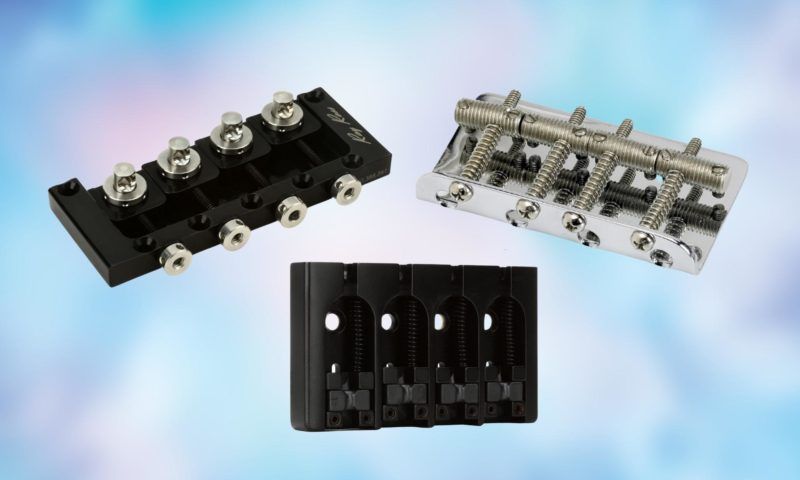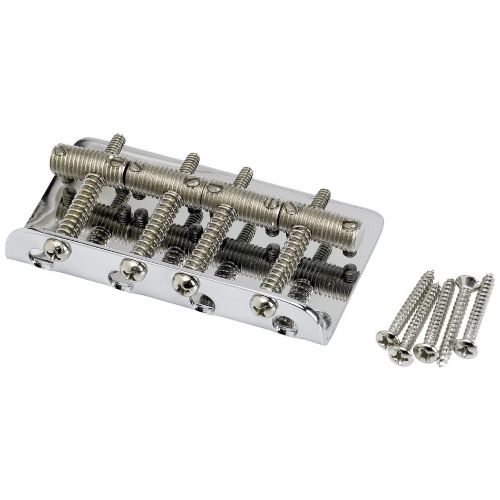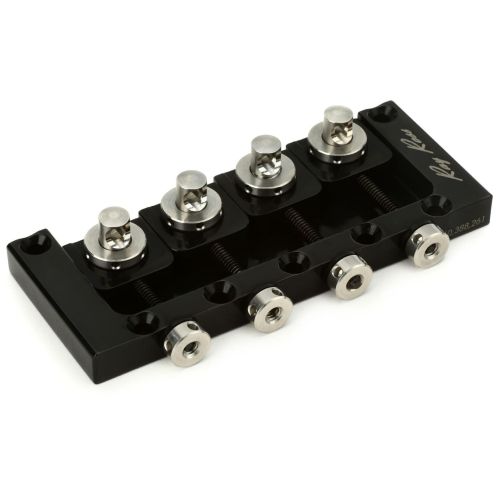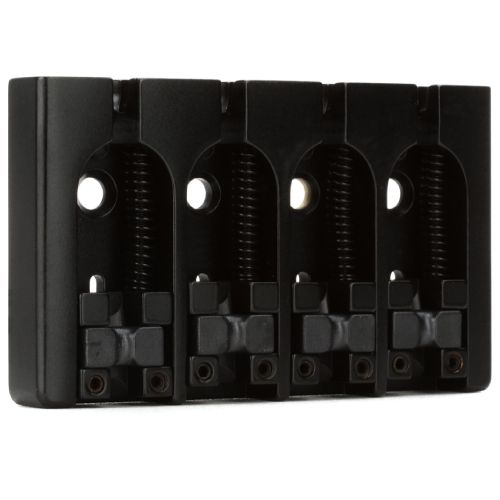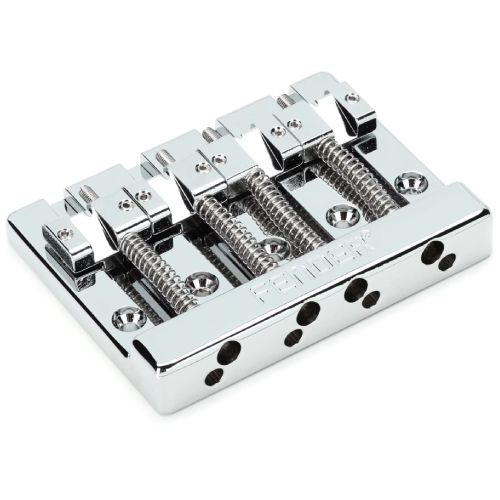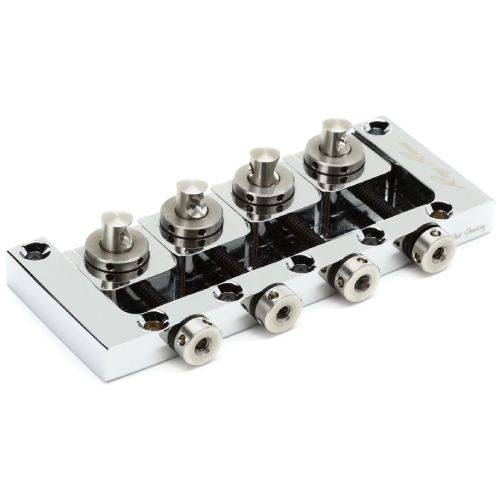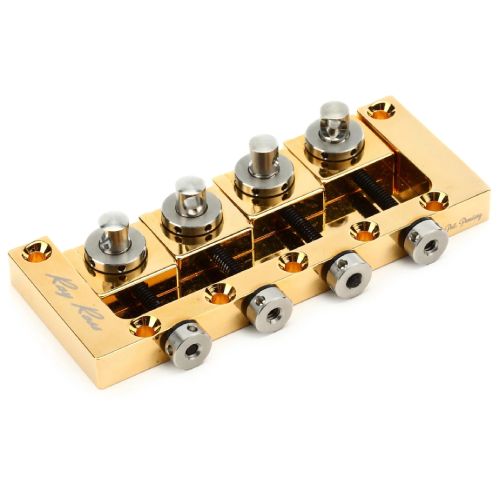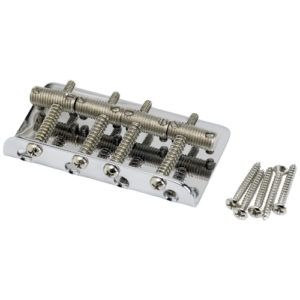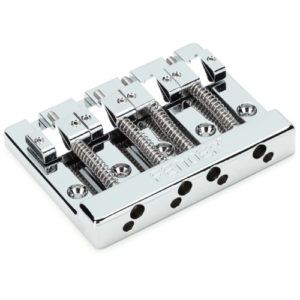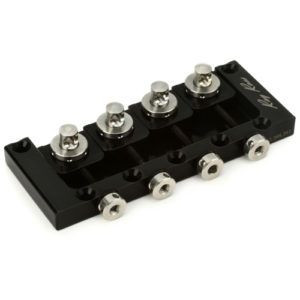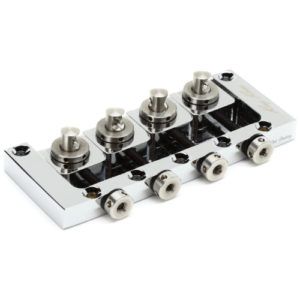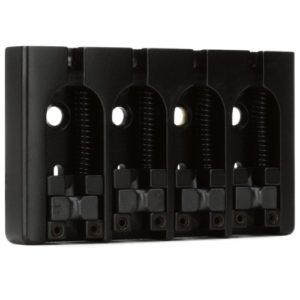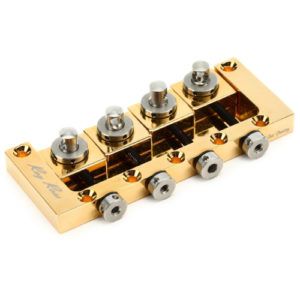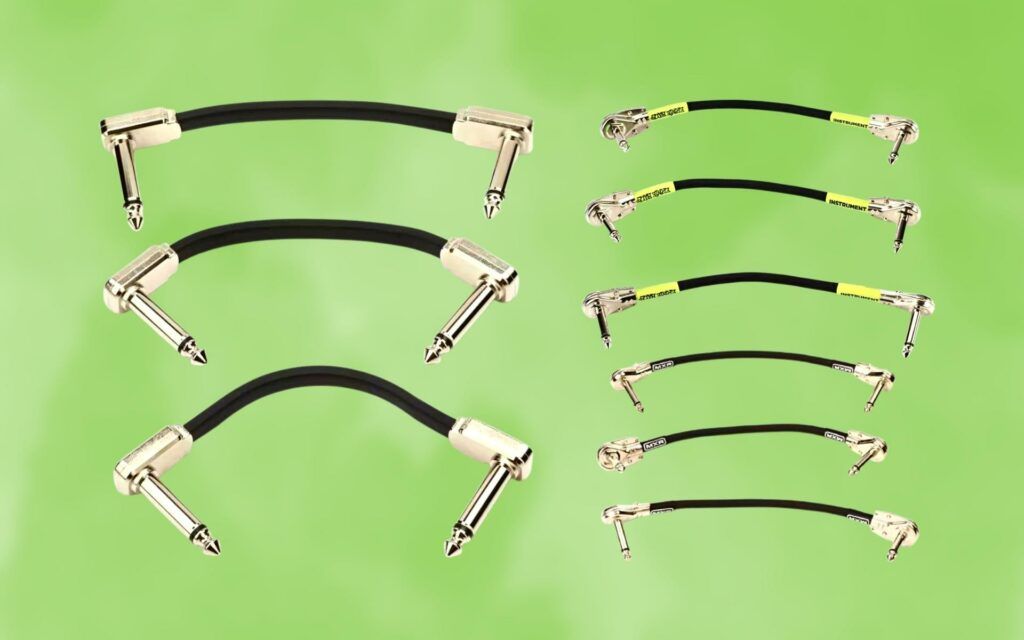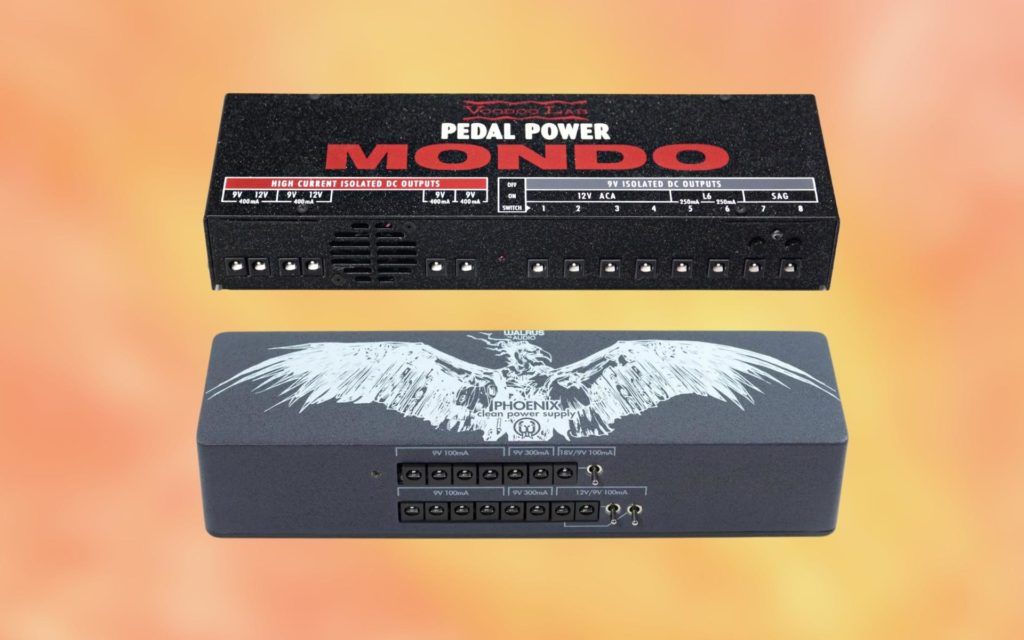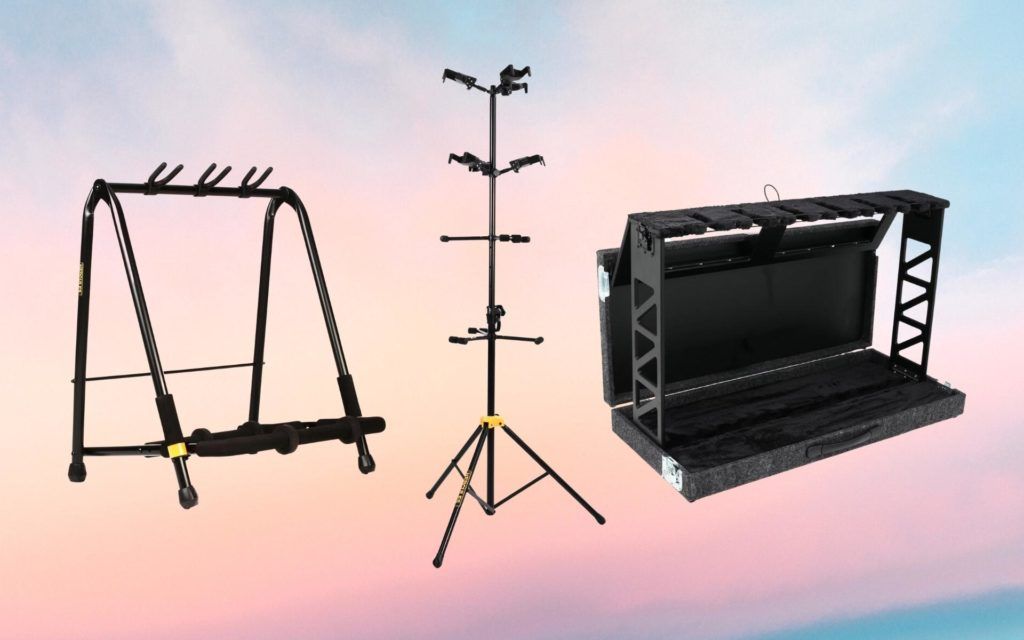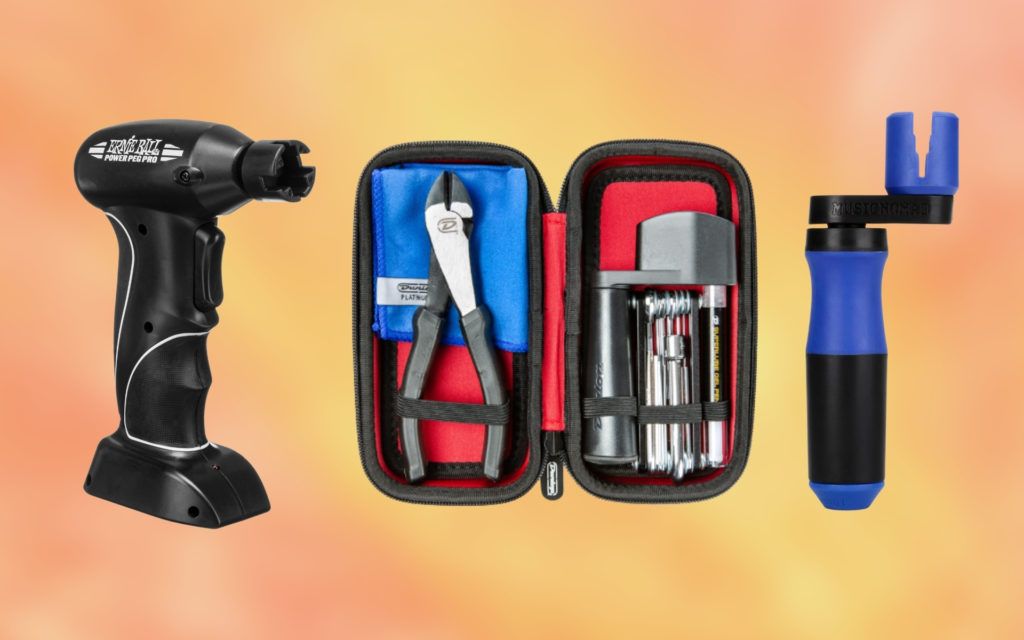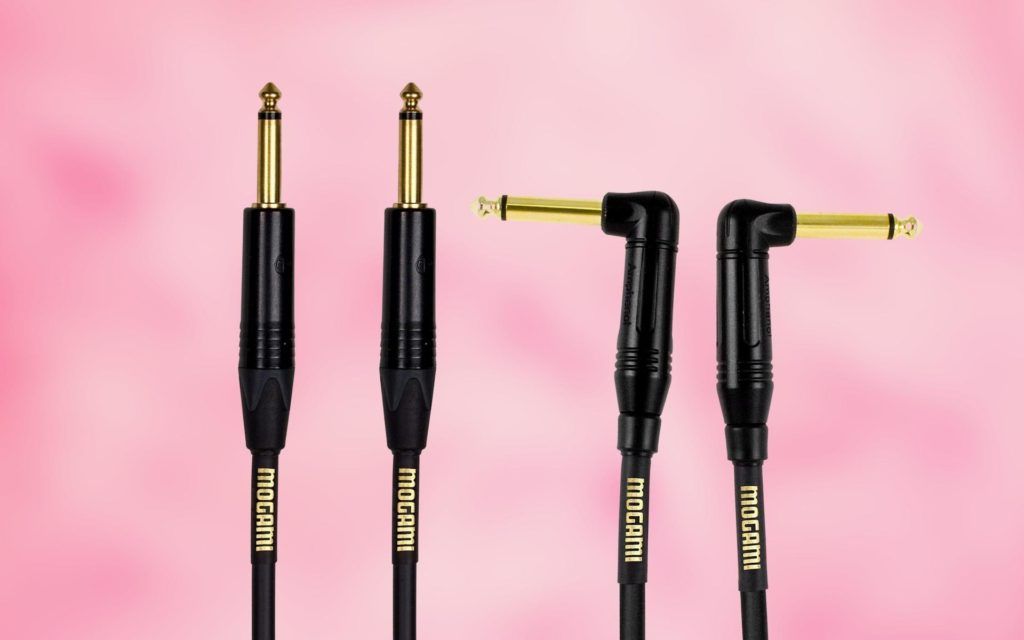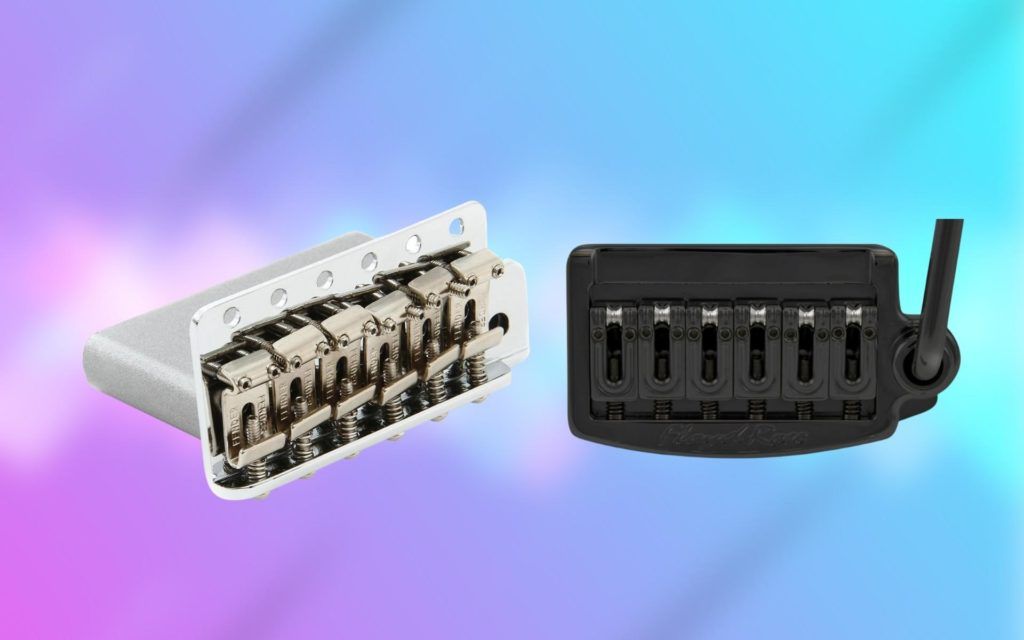We review products independently and our recommendations are genuine. If you purchase through links on our site, we may earn an affiliate commission. Learn More
Upgrading your bass bridge can be an effective way to make the instrument better suit your playing style.
The bass bridge also impacts tonal and dynamic aspects of your playing.
One of the main reasons that the bridge is such an integral component of a bass guitar is because the majority of the vibrations from the strings are transferred through it, to the body of the instrument.
If you’re considering replacing your bass bridge but feel confused about which qualities to look for, this guide will provide you with all of the information you need to make a calculated decision.
In a Rush Roundup
How We Tested
To test these different types of bass bridges, we analyzed a selection of key aspects. This included the durability and build quality of the bridge, the amount of string vibration is transferred to the body, and its compatibility with a range of bass types.
We also tested the bridge’s impact on the bass guitar’s ability to hold tuning for long periods, and whether it increased the sustain noticeably. In the reviews below, you can see the best bridges that we identified.
Best Bass Bridge Reviews
Fender Vintage Bass Bridge Assembly
Fender Vintage Bass Bridge Assembly Review
Fender revolutionized the bass guitar with the introduction of two iconic models – the Jazz and Precision. Unsurprisingly, they know a thing or two about manufacturing Precision and Jazz bass bridges of the highest quality.
This bass guitar bridge is based on the component used in Fender’s earliest four-string instruments, with the same appearance, size, and design. It also achieves the same tonal and dynamic results as those vintage bridges.
Equipped with OEM mounting hardware, this bridge is best suited to any Fender Precision or Jazz bass. Nevertheless, it is also compatible with many bass guitars made by other manufacturers, as they often base their design on Fender’s legendary duo.
The standard 5-screw mounting of this Fender Vintage bass bridge makes for easy installation, and the nickel-plated steel plate transfers vibrational energy from the strings to the body effortlessly.
I found the grooved shape of the saddles adds an authentic vintage feel to this bass bridge, and when you compare it side by side to the genuine bridges used on early P and J basses, it’s very hard to tell the difference!
Features
- Period correct design
- Made from chrome-plated steel
- Includes OEM mounting hardware
Pros
- Authentic Fender aesthetics
- Improves tuning stability
- Promotes a warm, resonant bass tone
Cons
- May look out of place on a non-Fender bass
Fender HiMass 4-String Bass Bridge
Fender HiMass 4-String Bass Bridge Review
The HiMass bass bridge by Fender combines their classic vintage design with some modern updates. This results in a stylish bridge, which offers both aesthetical and sound-related benefits.
I was particularly impressed by the effect this bass guitar bridge has on the resonance of the instrument. There is a significant lengthening of every note, regardless of where you find yourself on the fretboard.
This additional sustain is something that all bassists can benefit from, especially if you use effects pedals. Saturation effects like overdrive or fuzz will ring out for much longer with this bridge installed.
Although this bass bridge is designed mainly for Fender-style vintage instruments, it is compatible with most standard-sized basses. Installation is a breez\e, thanks to the 5-screw mounting design.
The bridge facilitates ¾-inch string spacing, which is adequate for all styles of playing, from jazz to funk, to heavy rock and metal bass.
Finally, installing this bridge is also likely to sharpen the attack of your bass, especially in the mid and treble range. This means that your note definition will be clearer, and your bass playing will feel more expressive.
Features
- Designed for 0.75-inch string spacings
- Chrome plated
- 5-screw mounting
Pros
- Increases tonal warmth
- High-quality materials promote longevity
- Enhances resonance of bass notes
Cons
- Best suited to vintage-style basses
Ray Ross RRB4B Saddle-less 4-string Bass Bridge
Ray Ross RRB4B Saddle-less 4-string Bass Bridge Review
With its unique, saddle-less design, the RRB4B by Ray Ross is a departure from conventional bass bridges. Firstly, it is very easy to install on any style of bass guitar, with a default string spacing of 0.75 inches.
One standout quality that I noticed when experimenting with this bass bridge was its impact on sustain. There is a noticeable additional length to every note played, whether you find yourself in the lower registers or the high-end of the instrument.
This bass bridge is as robust as they come. Made from solid naval brass, it holds your strings in tune for longer, making it a great choice for bassists who play with an aggressive or energetic style.
If intonation is a struggle for your bass, this bridge can help to rectify that problem. It makes adjustment very straightforward and secures the strings in place to ensure that they don’t gradually move over time.
Another aspect that makes this Ray Ross bass guitar bridge stand out is its classy black design. Regardless of the color scheme of your instrument, this bridge will slot in without attracting too much attention.
Features
- No-saddle design
- Compatible with 0.75-inch string spacing
- Made from solid brass
Pros
- Allows you to set intonation accurately
- Easy to adjust string action
- Improves clarity of bass tone
Cons
- String spacing cannot be adjusted
Ray Ross RRB4C Saddle-less 4-string Bass Bridge
Ray Ross RRB4C Saddle-less 4-string Bass Bridge Review
It speaks volumes about the quality of Ray Ross’ products that they feature on our list of the best bass bridges multiple times. This chrome bridge is also designed without the need for a saddle.
The effect that this bridge has on the tone of your bass is significant, to say the least. It increases the sustain of every note, and also provides a slight boost to the midrange frequencies.
When combined with gain-based pedals, such as overdrive or distortion, the Ray Ross RRB4C bass bridge excels. Due to the increase in sustain, it makes riffs sound more powerful without becoming muddy or unclear.
Included with this bass bridge are seven mounting screws. This means that no matter what the design of your bass, you will be able to choose the best way to install the bridge on the body.
The actions and intonation wheels make it easy to adjust these vital settings so that your bass is set up exactly how you want it to be.
Features
- Saddle-less design
- Standard 5-hole installation
- 0.75-inch string spacing
Pros
- Locks bass strings firmly in place
- Improves note length
- Encourages vibrational transfer from strings
Cons
- Unsuitable for very wide string spacings
Graph Tech PN-8370-B4 Ghost Loaded Hipshot A-Style Bass Bridge Review
Graph Tech is a company that has a reputation for innovation. This PN-8370-B4 bass bridge underlines that notion, due to its unusual design and distinguishable results on tone and dynamics.
It’s important to note that this device works best when it is combined with Graph Tech’s Ghost Acousti-Phonic preamp kit. However, it can be used with other pickups too, but the results may vary in quality.
Designed with a matte black finish, this bass bridge looks as good as it sounds. It is loaded with a set of piezo pickups, which you’d expect to find on an acoustic guitar.
I must admit I was a little skeptical about the sound of a bass guitar with piezo-style pickups, but it works very well. And if you don’t enjoy the sound, you can simply switch to the onboard magnetic pickups for a more conventional tone.
The PN-8370-B4, when combined with the recommended preamp, produces a luscious blend of acoustic and amplified bass tones. For styles like folk or indie, this may be the ideal bass bridge.
Features
- Designed to be used with Ghost Acousti-Phonic preamp kits
- Piezo-style bridge
- Matte black finish
Pros
- Combines magnetic and piezo tones
- Adds acoustic elements to the amplified output
- Very easy to install
Cons
- Works best when used with a specific preamp
Ray Ross RRB4G Saddle-Less 4-string Bass Bridge
Ray Ross RRB4G Saddle-Less 4-string Bass Bridge Review
The final bass bridge featured in our list is the Gold RRB4G, by prolific manufacturers Ray Ross. This classy component looks exquisite, and it also has the potential to make your bass guitar sound better.
This bridge’s impact on sustain shouldn’t be overlooked. It causes lower notes to decay at a much slower rate, almost like a compressor pedal. Also, it tightens up the low-end frequencies dramatically.
The way that this bridge can enhance the dynamic qualities of a bass guitar is through the transference of vibrations from the strings, to the body. When more vibrational energy reaches the pickups, the sound becomes more full-bodied.
It should also be noted that the authentic gold appearance of this bridge will significantly enhance the overall look of your instrument. The gold blends with most color schemes and designs effortlessly. ,
This bass bridge is designed to be used with any P or J-bass style instrument, but in reality, it can be fitted onto any conventional bass guitar.
Features
- Uses top pins to lock strings in place
- No saddle design
- Made from naval brass
Pros
- Classy gold design
- Simplifies intonation and action adjustments
- Makes your bass sound warmer and more full-bodied
Cons
- Best suited to string spacing of around 0.75 inches
Bass Bridges Buyer’s Guide
When it comes to deliberately creating bass tone, most musicians focus on aspects like strings, effects pedals, or their choice of amplifier. The bass bridge is often overlooked, despite its importance.
For an amplified bass guitar to make a sound, the vibrations must be transferred from the strings, through the bridge, into the body. This means that the bridge is just as important as any other component of the instrument.
Things To Consider When Buying
Consider the mounting pattern
Bass bridges are listed with specific mounting patterns, which relate to the way that they are attached to the body. Some are compatible with most bass guitars, while others are designed for five-hole or three-hole patterns.
Determine the suitable bridge mass
Bridges for bass guitar can be split into two distinct categories – low-mass, and high-mass. The former is more of a vintage design and is both thicker and heavier than its low-mass equivalents. The larger the bridge, the more resonant and thick the tone is likely to be.
Think about aesthetics
When we choose our bass guitar, some would argue that tone is the most important aspect. Others may value playing comfort more than sound, while some people make their decision based on appearance. In reality, we should combine each of these aspects when making our decision. The bridge you choose to install on your bass will alter its appearance, so it’s vital to consider which colors and designs are most compatible with your instrument before buying.
Why Bass Bridges Are So Important
A bassist can tailor the feel and tone of their instrument by changing their strings, altering the onboard pots, swapping out their pickups, or using different amplifiers and pedals.
The bridge isn’t likely to be the first thing that springs to mind when a bassist decides to improve or customize their instrument. Nevertheless, the bridge is a vital component that affects the performance of the bass in a whole host of ways.
Whether you feel that your bass would benefit from some revitalization, or you’d like to improve its tone, playability, or appearance, installing a new bridge has the potential to achieve all of this.
It is often wrongly assumed that a bass bridge, or tailpiece as it is often also called, simply secures the strings to the instrument’s body. This, however, is only one of many functions that the bridge carries out.
The bridge is responsible for the intonation of the strings, which impacts their tuning. It also determines the action of the strings, which is directly linked to the bass guitar’s playability and comfort.
Sonically, the bridge affects everything from the resonance of the notes you play on your bass, to the prominence of the low-end, midrange, and higher frequencies.
Bass Bridge Mass
Because the bridge directly impacts the way that the vibrational energy is transferred through the bass’ neck, body, and into the pickups, it’s important to understand how different sizes can impact the tone.
In most cases, a heavier bridge will result in more tonal depth, in addition to increased sustain. High-mass bridges tend to be installed on manufacturers’ high-end bass guitars for these reasons.
Indeed, bass tone is ultimately subjective, and there are some bassists who prefer the thinner, shorter-lived sound of low-mass bridges. For genres like funk or indie rock, I can see how a lighter bridge might be more appealing.
Bass Bridge Materials
The materials that are used to construct the bridge also affect its performance. The most common materials used are:
- Steel
- Zinc
- Brass
Brass is renowned for increasing the prominence of the low-end frequencies of a bass and is therefore often used on high-end models. Zinc and steel, when used exclusively, are common on affordable bass guitars.
It’s also common for manufacturers to combine these three materials, which can provide a balance of their qualities.
Using steel for the bridge plate and brass saddles is a popular combination that increases both the brightness of the high-end and the power of the low-end frequencies.
Bass Bridge FAQs
Does the Bass Bridge Impact Tone?
The bridge that is installed on a bass guitar is arguably just as important as the pickups when it comes to shaping the tone of the instrument.
Bas bridges affect the resonance of every note that is played on the strings. The influence of the bridge can be heard on every frequency band of the bass guitar, particularly when the instrument is played through a good amplifier.
Why is the Bass Bridge So Important?
A bridge is an essential component of a bass guitar. Without it, there would be nothing to hold the strings to the body of the bass, and the instrument would be rendered unplayable.
In addition to securing the bass strings in place, the bridge is also the link between the strings and the body in terms of the transference of vibration that has to take place for the instrument to be successfully amplified.
Once you’ve upgraded your bass bridge, you’ll understand exactly how much this underrated component matters to the overall tone and performance of the instrument.
Does the Bridge Affect Intonation?
In addition to impacting the tone and dynamics of your bass guitar, the bridge also affects the intonation of each string.
If your intonation is slightly off, meaning certain notes are flat or sharp, you can adjust the intonation by tightening or loosening the screws on the bridge to move it slightly, shortening or increasing the length of the strings that need fixing.
Investing in a good-quality bass bridge will help to prevent your intonation from going out, as the bridge will secure the strings in space and not allow them to move.

